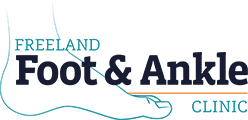 Most of us have had, or will have, an ingrown toenail at one time or another in our lives. Ingrown toenails are extremely common, often affecting the big toe. The condition can be painful, causing redness, swelling, and pain at the nail's edge. Luckily, the pain can be managed using simple home remedies.
Most of us have had, or will have, an ingrown toenail at one time or another in our lives. Ingrown toenails are extremely common, often affecting the big toe. The condition can be painful, causing redness, swelling, and pain at the nail's edge. Luckily, the pain can be managed using simple home remedies.
Occasionally (or, unfortunately, frequently for some folks) ingrown toenails can continue to worsen, leading to significant pain and potentially even a nasty infection.
Whether your ingrown toenail is mild, moderate, or severe, the good news is that you have options to help you get rid of your ingrown toenails and back to enjoying your daily activities without discomfort or restriction.
Getting Rid of an Ingrown Toenail at Home
Not every ingrown toenail can be treated at home, but many can. Home treatments might be a good choice for you if:
- You are only experiencing mild discomfort that isn’t significantly affecting your activities
- You don’t notice any signs of infection (no redness, swelling, pus under the nail)
- You are in good health and do not have diabetes, neuropathy, or any other condition that could inhibit your nerve function, circulation, or immune system.
For the most part, we recommend you keep your home care efforts simple, as there are not many home-treatment options that are actually effective. Nevertheless, here are some at-home ingrown toenail treatment tips:
- Soak your feet around 3 times per day, for about 15 minutes each time. (If you shower once or twice per day, you can count those as “soaks.”)
- After the soak, you can gently massage the skin surrounding the toenail, pulling it (again, gently) away from the danger zone.
- Avoid putting your toes in situations where they’re going to constantly get pinched or bumped. If the weather’s nice, opt for open-toed shoes. If you need to wear closed toes, make sure you wear loose-fitting socks and comfy, low-heeled shoes that provide a lot of wiggle room for toes.
How to Cut an Ingrown Toenail![Long toenails may cause problems when wearing shoes. Use the clipper cut it short for good hygiene.]()
As the nail grows out, continue your routine trimming. Avoid cutting the nail too short, or rounding in the corners. Just cut straight across, leaving just a little bit of length on the nail. Your nail will have fewer opportunities to snag if you trim this way.
Now that you know what you should do, it’s just as important to understand what you should not do:
- Don’t cut a V-shaped notch in the ingrown toenail, thinking that it will draw the corners out. It doesn’t work.
- Don’t try to cut or dig out a nail border on your own using clippers, a knife, scissors, etc. Most likely you will only make the situation worse and greatly increase your risk of infection.
- Don’t try to prop up the nail or place anything under it, such as dental floss or cotton. We don't recommend propping the nail or packing material beneath it because doing so can increase your infection risk (without improving your odds of success all that much.)
Getting Rid of an Ingrown Toenail in Midland, Saginaw, Bay City, and Beyond
If your ingrown toenail is causing more significant pain, is interfering with your activities, or has developed an infection, you should definitely come see a professional. The same goes for anyone with diabetes or compromised health. Waiting to see if home treatments will work just isn’t worth the risk of developing a dangerous infection.
Even in the most severe cases, we can quickly remove an ingrown toenail under local anesthesia, bringing a rapid end to the problem with no pain or discomfort.
There are a few different treatment options available, depending on your symptoms, your situation, and how frequently you have trouble with ingrown toenails.
- If your ingrown toenail seems to be a “one time” thing, or developed because of an accidental trauma (like stubbing your toe, for example), the best course of action may be for us to simply cut the ingrown toenail for you. This can relieve the pressure immensely, and most likely the nail will grow back normally.
- If your pain is more severe, or ingrown toenails are a recurring problem for you, we may instead recommend numbing your toe with a local anesthetic and removing the portion of the toenail that is becoming ingrown. This is usually combined with a secondary procedure on the nail matrix to keep that particular edge of the toenail from growing back.
While this second option may seem scary, we can assure you that it really isn’t! Everything is done under anesthesia, so you won’t feel a thing. By the time the sensation returns to your toe, you should already notice a dramatic improvement in the way you feel.
You’ll have some aftercare instructions to follow once you get home, but most people are able to return to the vast majority of their daily activities within 24 hours.
![onyfix]() Non-Invasive Treatment for Ingrown Toenails
Non-Invasive Treatment for Ingrown Toenails
Onyfix is brand new, state-of-the-art technology used to treat ingrown and involuted toenails. It provides a safe alternative for patients who may not be eligible for ingrown toenail surgery. Needle phobias, diabetes, pregnancy, breastfeeding, age, and many other external factors may prevent you from undergoing a traditional ingrown toenail removal procedure.
Onyfix is offered in our office. This treatment is safe, effective, non-invasive, and needle-free.
So as you can see, you really have no reason to hesitate on making an appointment with Dr. Dailey! He can help you ease your symptoms quickly, safely, and effectively. To schedule with us in Freeland, please call (989) 695-6788, or request an appointment online.


.jpg) Non-Invasive Treatment for Ingrown Toenails
Non-Invasive Treatment for Ingrown Toenails